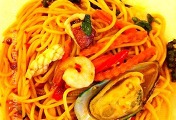KOREAN HANG OVER FOOD?
그거 아세요? 한국에 해장국이랑 태국에 해장국이랑 너무 닮았다는것을......
우리 제프리는 예기합니다. 이 남니요' 라는것을....
[조니 타이] - 15년 가까히 살면서 너무 그에게 무관심했나봅니다. 그는 내가 무엇을 먹는지 아는데...
진작 나는 내가 그가 무엇을 먹는지 잘 몰랐습니다.
오늘 이 해장국 떄문에.. 오늘 그가 무엇을 먹는지 자세히 알게되었습니다.
대체 이 해장국은 어떻게 진화를 걸쳐 온것일까요?
최근에 그리고 가끔씩.. 제프리가 주방에서 요리를 합니다.
그런데 해장국 비슷하게 하는것 같은데...
아니구요.... 어느날' 제프리가 요리하면서 예기를 하더군요.' 이건 행오버 푸드 북쪽 음식이라면서...
HANGOVER
아무래도 이 해장국은 중국에서부터 흘러 내려 온것 같아요, 그리고 중국인들이 많이 거주하는 태국에 치앙라이 지역의 향토 음식이 된듯한 묘한 기분이....
해장국
aejangguk refers to all kinds of guk (soup) eaten as a hangover cure in Korean cuisine. It means "soup to chase a hangover and also calledsulguk (술국) in pure Korean.
It usually consists of dried Napa cabbage, congealed ox blood (similar to blood pudding), and vegetables in a hearty beef broth.
In the Nogeoldae, a manual for learning spoken Chinese published in the late Goryeo Dynasty (918-1392), the term seongjutang (醒酒湯) appears. It means "soup to get sober" and is assumed to be the origin of haejangguk. According to the record, the soup consists of thinly sliced meat, noodles, scallions, and powder of cheoncho (천초, fruit skins of Zanthoxylum piperitum) in a broth. The composition is same as the basic recipe of a present day haejangguk.
Although haejangguk is not mentioned in cookbooks written during the Joseon Dynasty (1392–1910), relevant contents can be seen in genre paintings and documents of the late Joseon Dynasty. In Shin Yun-bok (b. 1758)'s painting titled Jumakdo (주막도 "Painting of the Tavern), a scene regarding haejangguk is well depicted. A group of hallyang (閑良 a kind of prodigal people with no job gather to eat haejangguk, while ajumo, female owner of jumak (a tavern) ladles boiling soup out of a sot (cauldron).
This dish seemed to be eaten not only by commoners.According to Haedong jukji (海東竹枝), poetry collection written by Choe Yeong-nyeon(崔永年 1856∼1935[6]),[7] haejangguk is referred to as hyojonggaeng (曉鍾羹), which literally means a "dawn bell soup"
The book states that the area within the Gwangju Castle (Namhansanseong[8]) is known for making the soup well. The ingredients for the soup are inner parts of Napa cabbage, and kongnamul (soybean sprouts), mushrooms, beef galbi (short ribs), sea cucumber, and abalone. They are mixed together with tojang (fermented bean paste) and are simmered thoroughly for a day. The cooked soup is then put into a hangari (an earthen crock) covered with a pad of cotton, and sent to Seoul at night. When the dawn bell rings the time, the soup is delivered to a house of jaesang (high-ranking officials).
The hangari is still warm and the soup is very good for relieving hangovers. The record suggests that hyojonggaeng is either the first delivery food to cure a hangover after a banquet held by jaesang was ended or was used as a bribe.[5]
Types[edit]
There are various types of haejangguk according to region based on ingredients and recipe that give each variety its own characteristic taste. Haejangguk of the Seoul region is a kind oftojangguk (soybean paste soup) made with kongnamul, daikon, napa cabbage, scallions, coagulated ox blood, and tojang in a broth. The broth is prepared by simmering ox bones in a pot with water for hours. The neighborhood of Cheongjin-dong is famous for the Seoul style haejangguk.
In the city of Jeonju, people eat "kongnamaul gukbap" as a haejangguk. A little lean kongnamul with the length of an index finger are poached in water diluted with a small amount of salt. Along with the kongnamul, steamed rice, sliced ripe kimchi, scallions and garlic, beef broth, and a small amount of shank are put into a ttukbaegi (a small earthen pot) over heat and thekongnamul broth is poured into it. When the ingredients are boiled, a raw egg is cracked over the soup. Once it is served, a mixture of sesame seeds and salt, scallions, minced garlic, chili pepper, and chili pepper powder, and saeujeot (salted fermented shrimp) are put into the haejanguk are added according to the diner's taste. It is said that, when eating haejangguk, if the diner drinks a cup of moju (母酒) made by boiling a fermented mixture of makgeolli (a type of rice wine), sugar, and wheat flour, the combination would be good to alleviate the hangover.[3][10]
There are also haejangguk with cold soup. In the seashore of Sea of Japan (East Sea), especially in the Uljin region, "ojingeo mulhoe guksu" (오징어물회국수) is eaten as a haejangguk. Finely sliced squid like noodles is mixed with a sauce and cold water is poured over it along with ice cubes.
- Ugeojiguk (우거지국) - made with ugeoji (우거지, dried leaves of Chinese cabbage)
- Kongnamulguk (콩나물국) - made with kongnamul (bean sprouts)
- Seonjiguk (선지국) - made with seonji (선지, coagulated ox blood)
- Jaecheopguk - made with jaecheop (Corbicula fluminea) and buchu (garlic chives)
- Gulgukbap - made with oyster and garlic chives
'여행정보::TRAVEL > 맛있는 여행' 카테고리의 다른 글
| 태국식 전통 간식 룩춥 (ลูกชุบ) 을 아세요? (0) | 2014.06.24 |
|---|---|
| 태국식 해물 스파게티' 스파게티 키 마우탈래(สปาเกตตีผัดขี้เมาทะเล) (0) | 2014.06.20 |
| 마구로 (참치 회) 아보카도 (まぐろアボカドユッケ ).. 준영이형 커플 보세요! (0) | 2014.05.31 |
| 현금 50만원 ~ 쌍팬댁 2탄' 왕(王) 언니! 오픈기념 이벤트가 지금 실시되고 있습니다. (0) | 2014.04.22 |
| 태국 방콕에 떡복이(TOPPOKKI)를 아시나요? (0) | 2014.04.21 |







댓글